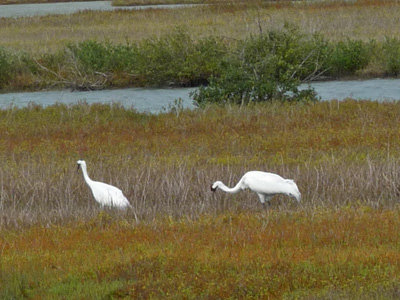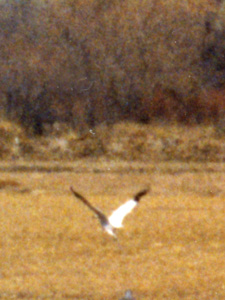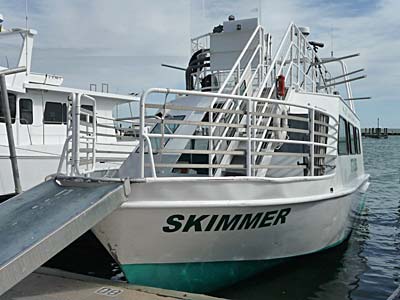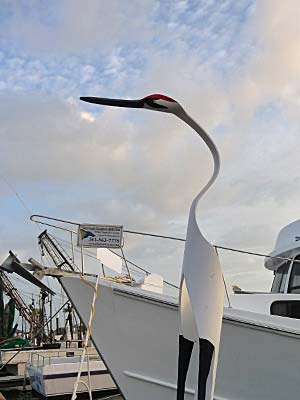
Whooping Cranes
Grus americana
This North American cousin has the dubious distinction of being one of the most endangered birds in the world. In the 1950s, their population was 23 birds. Total. That's it. Every whooping crane alive today (estimated at about 600 birds) is descended from that tiny pool of individuals, which means they don't have much genetic diversity. One new virus could wipe them all out.
Efforts to breed them in captivity and then reintroduce them into the wild have been remarkably successful, which is why they are still around today. There are now two "stable" populations. (map of their range) One original group winters along the Gulf Coast of Texas and breeds in Northern Canada. The other breeds in Wisconsin and winters in Florida. Small non-migratory populations also live in Florida and Louisiana.
Human Heroes

Hunting and habitat loss were the main causes of their original plunge to endangered status. Currently, the biggest threats are collisions with power lines, drought, and a lack of genetic diversity. The introduction of wind turbines into the migration corridor is another significant concern.
Another important issue is their dependence on blue crab while they winter in Texas and Florida. Though they do eat other things, blue crabs are rich in the calories, protein, and calcium the cranes need to be healthy enough to raise chicks after the long journey back to their breeding grounds. Blue crabs require brackish marshes of a particular salinity to thrive. The marshes in Aransas National Wildlife Refuge have been perfect, but unfortunately in recent years humans have diverted some of the water from the rivers that feed the marshes. The drought has aggravated this problem, and the blue crab population has declined. If this continues, the whooping crane population will decline with it. You can read more about this tricky balance at Learner.
The Canadensis Experiment


The pictures in this section are blurred; these cousins were struggling with an identity crisis and didn't want to be clearly photographed. They were wintering in New Mexico and struggling with the angst of learning who they truly were. Humans thought my Grus canadensis (Sandhill crane) clan might be able to help save the Grus americana (Whooping crane) branch of the family. Their intentions were good; they placed more than 100 eggs in Sandhill nests in Idaho. It seemed to work, but the Whoopers began to act like they were Sandhills. They even chose Sandhill mates. What can I say, we're incredibly alluring—the Whoopers just couldn't resist us! While you can hardly blame the Whoopers for their excellent taste, the humans were afraid they absorbed by the Sandhills so they stopped bringing eggs to us to foster.
Want to See Whooping Cranes?


One of the easiest ways for humans to see Whoopers is for them to visit the International Crane Foundation reserve in southern Wisconsin. They are home to ALL the different cranes of the world. They also have crane cameras during the breeding season. If you want to catch a glimpse of a wild population, your best bet is during the winter since Whoopers are shyer during the summer breeding season. Even then, adult Whoopers don't congregate in large, easily spotted sedges (for some reason that's what you humans call a group of cranes) like some of my other relatives do. Adults stay with their mates and recent chicks, while subadults (like the trio pictured at the top of the page), hang out in very small sedges. The most reliable, good views of Whoopers in the Texas Aransas National Wildlife Refuge are from the water and excellent tours are available.
More Whooping Crane Information

- When humans raise baby whooping cranes now, they interact with them using puppets, so the birds don't imprint on humans.
- Whooping cranes are the tallest flying birds in North America, though they are smaller than our Indian Sarus cousins.
- Once whooping crane conservation became a priority in the 1940's and 1950's, the population stabilized and began to grown. By the turn of the century, the only natural flock of Whoopers (the sedge that winters at Aransas National Wildlife Refuge) had grown to 200 birds. When the Sandhill fostering program was discontinued, humans decided to create a new population that breeds in Wisconsin and winters in Florida. They teach the birds to migrate by leading them with a small plane.
Want to Know More?